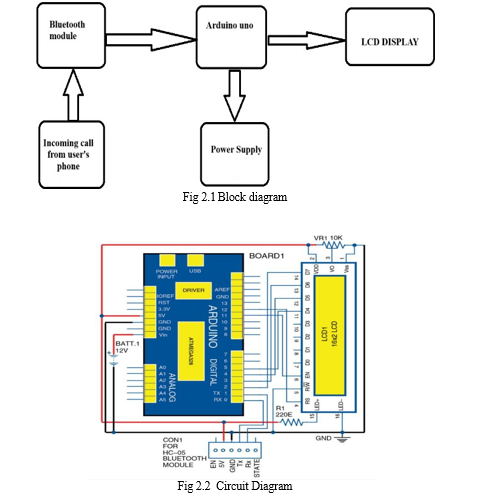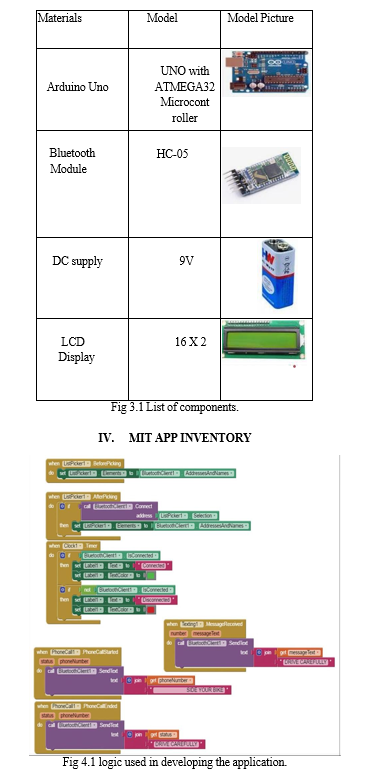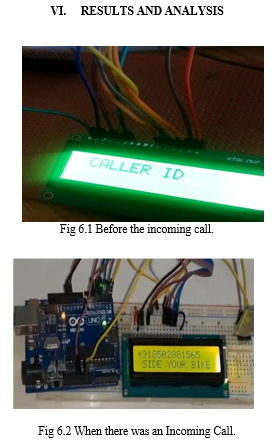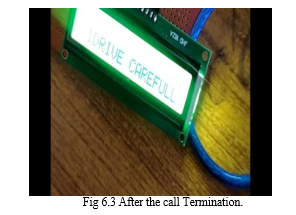Ijraset Journal For Research in Applied Science and Engineering Technology
- Home / Ijraset
- On This Page
- Abstract
- Introduction
- Conclusion
- References
- Copyright
Wireless Caller ID Display for Bikers
Authors: Mr. N. Rama Krishna, S. Sandhya Lakshmi, Y. Manasa, B. Sushma, J. Aishwarya
DOI Link: https://doi.org/10.22214/ijraset.2024.60938
Certificate: View Certificate
Abstract
The project\'s primary focus is a Bluetooth-enabled mobile phone interface. The Arduino microcontroller in this project is also programmed using the Arduino IDE software through a USB port on the Arduino board. The Bluetooth module HC-05 operates on serial communication and receives serial information via a software program. The data is sent through the Bluetooth module after being received from the app. The DC unit on the bike can be connected to the DC supply. The application begins to function in real time as soon as the bike is turned on. After Bluetooth receives a serial transmission from the user\'s phone, it is sent to an Arduino board for processing before being displayed on an LCD screen to show caller ID details, including the user\'s mobile number. Additionally, the display alerts the user or provides a warning to stop the bike. In this instance, the cell phone serves as a transmitting tool. Because Android phones can operate software applications and use Bluetooth, they are the required device for the user\'s phone. Global systems for mobile communication (GSM) are not recommended since they could end up being more expensive.
Introduction
I. INTRODUCTION
Human life should be easier and safer when it comes to the order of Arduino electronics. These days, using a mobile phone is generally the reason behind bike accidents. As a result, the driver may not be able to use their phone while operating a vehicle because it may be in their pockets or behind them. The focus of this project is primarily on the communication between the Arduino Uno R3, the driver's phone, and the Bluetooth module in order to avoid any difficulties. In this case, using a Bluetooth module rather than a GSM module shows to be more cost-effective because Bluetooth technology is wireless and has grown in popularity. The needs of personal communication and mobile phones these days make bandwidth easy to use. The wireless part's communication channel is managed by Bluetooth technology. The Bluetooth module uses two devices to send and receive data. With the aid of the host controller interface, the Bluetooth module can receive and transmit data from a host system (HCI).The application is digitalized so that it can send characters to drivers' cellphones and use Bluetooth, which the ArduinoR3 is connected to receive. Even the app's main structure, developed by MIT App Inventor, offers interactive GUI applications that convey the designated characters. Two methods exist for using Bluetooth communication. Two methods are available: the first is for data reception from the controller, and the second involves using our device's Bluetooth to control the system. Additionally, the Massachusetts Institute of Technology now maintains a web application integrated development environment that was first made available by Google. Since the HC-05 Bluetooth module operates on serial communication, the Android app is designed to transmit serial data to it. Data from the app is received and sent from the Arduino Rx pin to the Bluetooth module's TX pin.
II. METHODOLOGY
The goal is to display the caller Id on LCD by interfacing Bluetooth module with mobile application ,developed using MIT APP INENTORY Environment. This system requires components such as a Arduino Uno, Bluetooth module, LCD, mobile application .
The steps in methodology are as follows:
- Configuring the Bluetooth Module (HC-05) with the required libraries and software to interface with mobile application and LCD module.
- Developing a mobile application with the required features using MIT APP INVENTORY environment.
- Creating a serial communication channel with a mobile application by connecting the Bluetooth module to the LCD.
- Testing and assessing the system's functionality performance.
Using serial communication, an Arduino, an LCD, and a mobile application make up the wireless display system for bikers. The Arduino connects to the mobile app over Bluetooth or Wi-Fi, reads data from sensors, prepares it for the LCD, and initiates communication. The smartphone app connects to the Arduino and trades data with it, making it easy for users to interact and view the display. The accuracy and dependability of the system are ensured by extensive testing and troubleshooting. Longer battery life is achieved by optimizing power. The equipment is installed on the bike once it has been tested and documented, following all safety requirements and user manuals.

III. HARDWARE COMPONENTS
The wireless caller ID display for motorcyclists project brings together a number of essential elements to offer a cutting-edge riding experience. The Arduino microcontroller, which communicates with sensors like speed and GPS, is the brains behind the system. This microcontroller is essential to gathering and processing information about the biker's trip. Furthermore, a Bluetooth module (HC-05 or HC-06) makes it possible for the Arduino and a specialized mobile application to communicate wirelessly and smoothly.
The Arduino project offers a cross-platform application called the integrated development environment (IDE). The Arduino Integrated Development Environment (IDE) is a free integrated toolset for configuring an Arduino processor. The coding is finished in embedded C. The Arduino IDE software includes a text editor for writing code, many menus, a toolbar with buttons for frequently used activities, and a text console. In order to upload programs, it establishes a connection with the Arduino hardware and communicates with it. The pins are specified inthe void setup() method. The void loop () contains the routines toexecute various device actions (ON/OFF). These are managed and monitored by the server.
The HC-05 Bluetooth SPP (Sequential Port Convention) module is easy to use and is intended for a basic remote sequential association setup. The HC-05 Bluetooth Module is an amazing remote communication solution because it can be used in an Expert or Slave configuration. With a full 2.4GHz radio handset and baseband, this sequential port Bluetooth module is fully qualified for Bluetooth V2.0+EDR Improved Information Rate) 3Mbps Tweak. The frequencies at which Bluetooth operates are between 2.400 and 2.4835 GHz, or between 2.402 and 2.480 GHz, which includes monitor groups that are 2 MHz wide at the base and 3.5 MHz wide at the top.18]
This is in the global unlicensed (albeit not unregulated) short- range radio recurrence band of 2.4 GHz for mechanical, logical, and clinical (ISM) applications. Bluetooth sends each package on one of 79 designated Bluetooth channels, bundling the information that is sent. The transmission capacity of each channel is 1 MHz. It typically executes 1600 leaps every second while having adaptive recurrence bouncing (AFH) turned on. Bluetooth Low Energy divides data at 2 MHz, requiring 40 channels.
An LCD is a light-adjusting display or other electronically controlled optical device that makes use of the qualities of liquid precious stones connected to polarizers. Instead of emitting light directly, fluid precious stones need a backdrop light or reflector to produce monochromatic or shaded images .
LCDs can display fixed images with ignorant content that can be seen or hidden, such as current text, numbers, and seven-section displays, like in a computerized clock, or discretionary pictures (like in a generally useful PC show). They both make use of the same fundamental idea, but distinct presentations have larger components, whereas subjective images are created with a network of tiny pixels.
LCDs can normally be either positive (on) or negative (off), depending on the polarizer scheme. Character negative LCDs, on the other hand, will have a dark foundation with letters that are the same tone as the background illumination, while character positive LCDs will have dark writing on a foundation that matches the shade of the backdrop illumination. The distinctive appearance of white on blue LCDs is achieved through the addition of optical channels.
The standard size of battery for the first portable radios was the nine-volt battery, or 9-volt battery. It features a captured snap connector at the top and a rectangular crystal shape with adjustable edges. This kind is frequently seen in smoke alarms, walkie-talkies, and tickers.
The nine-volt battery design is typically available in battery-powered structures with nickel-cadmium, nickel-metal hydride, and lithium particles, as well as in critical carbon-zinc and antacid science. Because of their high mercury content, this business has not produced mercury-oxide batteries in a number of years. This organization's assignments include MN1604 6LR61 (for anti-acid) and NEDA 1604 and IEC 6F22 (for zinc-carbon). Ignoring science, the size is typically allocated PP3, an assignment formerly reserved only for carbon-zinc, or in some countries, the majority of nine-volt soluble batteries are made up of six separate 1.5 V LR61 cells packaged in a wrapper.
Although they are 3.5 mm smaller than LR8D425 AAAA cells, these cells are marginally more modest and can be used in place of those cells for specific devices. Six level cells are stacked in carbon-zinc kinds, and to prevent drying, they are covered with a moisture-resistant material. Three series cells are used to create essential lithium kinds. Four percent of basic needed batteries were 9-volt batteries.
The user interface is a mobile application that was created especially for this project and gets updates in real time from the Arduino. Caller ID data and other pertinent information are extracted by the application and shown on the LCD display in an understandable fashion.
By placing the LCD display in the rider's line of sight, it guarantees that vital information—like speed, navigational instructions, and caller details—is always visible and accessible, encouraging safer riding.
To guarantee that the complete system runs continuously while riding, a 9V power source is included. This power source adds to the dependability and durability of the system by supporting the LCD display in addition to the Arduino and Bluetooth module. The Arduino is used in the system's workflow to gather data from sensors, process it, and wirelessly send changes to the mobile application using Bluetooth.
This all-inclusive system offers benefits including vital measurements and instantaneous caller ID information, which enhance the riding experience. Convenience and safety are improved by the LCD display's user-friendly interface. To confirm the precision and dependability of data transmission and display, extensive testing is carried out. During long bike rides, power optimization techniques are used to improve battery life.

V. ALGORITHM
- Step 1: Configure the caller ID device that is mounted next to a bike's dashboard.
- Step 2: The Android software is linked to the Bluetooth module and it is paired with the user's mobile device.
- Step 3: MIT App Inventor is used to create the software, and Android is coded using the Android IDE.
- Step 4: The phone number is shown on the model's LCD display as soon as the user's phone receives an incoming call.
A. Construction and Working Algorithm
- The circuits work with a 12v or 5v regulated power supply. The microcontroller in Arduino requires 5v but the bike is already connected to 12volts battery.
- The Bluetooth module used in this project supports master slave mode serial communication using these features it can communicate with other Bluetooth enabled devices like android smartphones. The module runs on 3.3volts to 5volts power supply.
- The16x LCDisused display message as soon as the bike’s engine starts.
- Pins3,4,5,6, of the lcd are the control lines connect to 10kilo ohms present (VR1),pin12,GND and pin 11 of Arduino respectively .Data pins 11,12,13 and 14, of the lcd are connected to pins 5,4 ,3 ,2 of Arduino, respectively. Present is used to adjust the contrast of the lcd.
- Software for the wireless caller id display is written in Arduino programming language. Arduino is programmed using ArduinoIDE.
- This project includes an android application developed on MIT app inventor platform. Export this app as caller id. apk file, or with any other suitable file name. Install caller id .apkfile on your smartphone.


VII. ADVANTAGES
A wireless caller ID display for motorcycles might be a helpful tool that lets riders read and receive caller information from their cellphones without stopping or fiddling with them while they're on the road. By giving crucial information at a glance, this kind of gadget will improve convenience and safety.
When creating a wireless caller ID display for bicyclists, keep the following characteristics and factors in mind:
- Bluetooth connectivity: In order for the gadget to receive caller information and incoming call notifications, it must establish a Bluetooth connection with the rider's smartphone.
- Compact & Lightweight: Whether mounted on a bike's handlebars or somewhere else on the frame, the caller ID display should be easy to install, lightweight, and compact.
- Durable and Waterproof: The gadget needs to be able to tolerate falls, vibrations, and shocks in addition to being waterproof because bikers may experience a range of weather conditions.
- E-Ink or LED Display: E-Ink or LED display technology is the best choice for visibility in various lighting circumstances, such as direct sunlight. By doing this, the caller information would be made easily viewable.
- Options for Customizable Display: Users may be able to set the display to show only the most important caller information, including the caller's name, phone number, or unique identification. By doing this, distraction and information overload are reduced.
- Vibration or Sound Alerts: To inform the rider of an incoming call, the device may also vibrate or emit sound alerts, in addition to visual information.
- Integration with Navigation Apps: Turn-by-turn directions might be provided via the caller ID display in conjunction with navigation apps, improving the entire riding experience.
VIII. APPLICATIONS
The convenience, security, and communication that come with riding can all be improved with a wireless caller ID display for bikers. Some possible uses for this kind of device are as follows: Caller Identification, Hands-Free Communication, Navigation and Directions, Text Message Alerts, Emergency Alerts and Notifications, Fitness and Health Monitoring, Music and Audio Playback, Group Riding Communication, Smartphone Integration: , Safety Alerts and Features, Local Points of Interest, Language Translation, Social Connectivity, Event and Race Information, Customizable Interfaces.
In the end, a wireless caller ID display has a wide range of uses for bicycles, ranging from casual riders to die-hard fanatics. It can be customized to fit the demands and tastes of various cycles. Ensuring safety and reducing distractions throughout the travel are of utmost importance, and offering pertinent and helpful information is crucial.
Conclusion
In conclusion, the concept called Wireless Caller ID Display for Bikers provides a smooth and creative way to improve the bicycling experience. This clever solution shows caller ID information in real time right on the bike\'s dashboard thanks to the integration of cutting-edge technologies including Android apps, Bluetooth modules, and Arduino microcontrollers. In addition to improving general convenience, this encourages safer riding by enabling bikers to be aware of incoming calls. While the LCD display clearly and easily provides the caller information, the Android application\'s user-friendly interface ensures straightforward interaction. An exacting approach that puts accuracy, responsiveness, and power efficiency first is evident in the algorithmic workflow, which spans from Bluetooth pairing to LCD display refreshes. By seamlessly integrating communication technology into the rider\'s trip, this system strives to create a dependable and user-centric solution, improving the bike experience through rigorous testing and deployment considerations. The wireless caller ID display system for bikers will continue to be improved as the project approaches implementation thanks to continuing adjustments and user input.
References
[1] P. Subha, K. Balasubramaniam, S. Vairamani, and R. Uma, International Journal of Scientific & Engineering Research, Volume 7, Issue 5, May-2016. [2] S. V. Khot, A. S. Badwaik, S. N. Deshmukh, International Research Journal of Engineering and Technology (IRJET), Volume 04, Issue 03, Mar-2017. [3] Y. V. Subbareddy, K. Krishnaiah, M. Madhavi, International Journal of Innovative Research in Computer and Communication Engineering, Volume 3, Issue 8, August 2015 [4] K. Bhuvaneshwari, M. Rajalakshmi, International Journal of Advanced Research in Computer Engineering & Technology (IJARCET), Volume 5, Issue 1, January 2016. [5] M. K. Khan, S. Akter, M. M. S. Mollah, 2016 IEEE Region 10 Symposium (TENSYMP), Bali, Indonesia, 2016, pp. 408-412, DOI: 10.1109/TENCONSpring.2016.7519431. [6] V. Prabhakaran, R. N. Prabu, International Journal of Engineering Science and Computing, Volume 6, Issue 5, May 2016 [7] I. Ferdoush, S. Ahmed, A. Khan, 2018 4th International Conference on Electrical Engineering and Information & Communication Technology (ICEEICT), Dhaka, Bangladesh, 2018, pp. 1-5, DOI: 10.1109/ICEEICT.2018.8469897. [8] M. R. N. Sam et al., 2018 IEEE Symposium on Computer Applications & Industrial Electronics (ISCAIE), Penang, Malaysia, 2018, pp. 1-6, DOI: 10.1109/ISCAIE.2018.8644747. [9] M. Arun Kumar, M. N. Jagadish, P. Jayaprakash, 2017 International Conference on I-SMAC (IoT in Social, Mobile, Analytics and Cloud) (I-SMAC), Palladam, India, 2017, pp. 363-368, DOI: 10.1109/I-SMAC.2017.8058318 [10] S. Gayathri, A. Menaka, K. Premalatha, 2018 IEEE International Conference on Power, Instrumentation, Control and Computing (PICC), Thrissur, India, 2018, pp. 1-5, DOI: 10.1109/PICC.2018.8761148. [11] K. V. Viswanadh, S. R. Krishna, 2019 International Conference on Communication and Signal Processing (ICCSP), Chennai, India, 2019, pp. 0534-0539, DOI: 10.1109/ICCSP.2019.8697951. [12] N. V. Nayak, R. K. Mahapatra, 2018 IEEE Calcutta Conference (CALCON), Kolkata, India, 2018, pp. 224-229, DOI: 10.1109/CALCON.2018.8629033 [13] M. A. Hossain, A. S. M. Mahmudul Hasan, M. R. Ahmed, 2017 2nd International Conference for Convergence in Technology (I2CT), Mumbai, India, 2017, pp. 135-139, DOI: 10.1109/I2CT.2017.8226196. [14] V. H. Shah, A. D. Patel, K. H. Shah, 2018 International Conference on Current Trends towards Converging Technologies (ICCTCT), Coimbatore, India, 2018, pp. 1-5, DOI: 10.1109/ICCTCT.2018.8550829. [15] S. Sudha, M. V. Srividya, 2019 IEEE Calcutta Conference (CALCON), Kolkata, India, 2019, pp. 1-6, DOI: 10.1109/CALCON45922.2019.8975047. [16] N. Pandiarajan, S. P. Rajagopalan,2018 IEEE Calcutta Conference (CALCON), Kolkata, India, 2018,pp.160-163,DOI: 10.1109/CALCON.2018.8629041.
Copyright
Copyright © 2024 Mr. N. Rama Krishna, S. Sandhya Lakshmi, Y. Manasa, B. Sushma, J. Aishwarya. This is an open access article distributed under the Creative Commons Attribution License, which permits unrestricted use, distribution, and reproduction in any medium, provided the original work is properly cited.

Download Paper
Paper Id : IJRASET60938
Publish Date : 2024-04-24
ISSN : 2321-9653
Publisher Name : IJRASET
DOI Link : Click Here
 Submit Paper Online
Submit Paper Online

